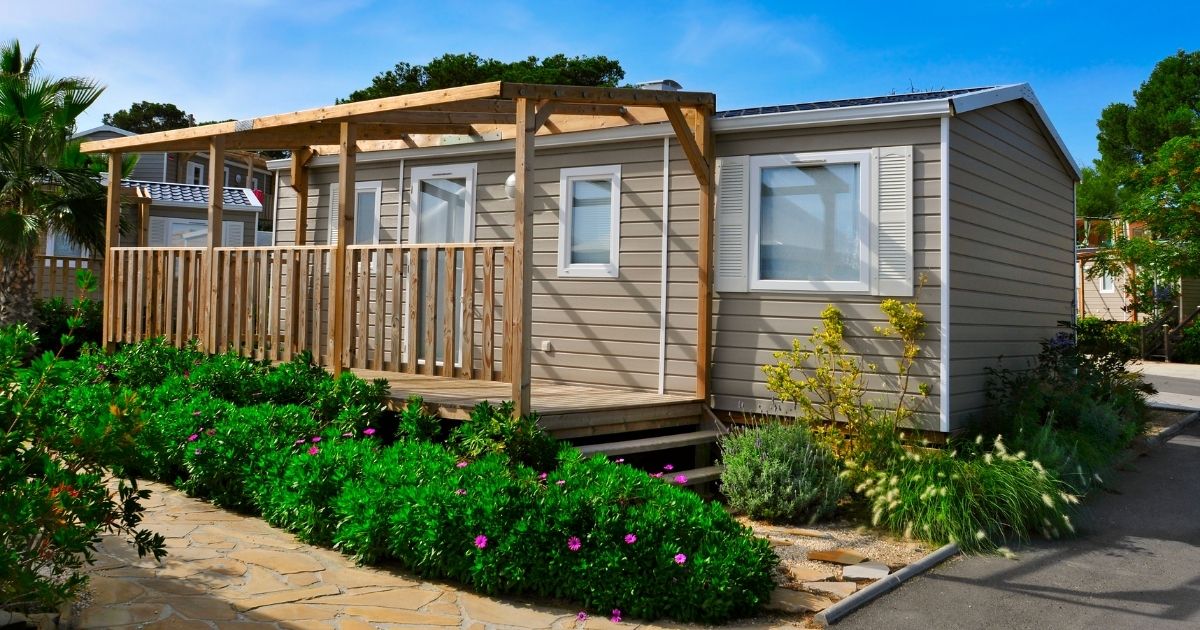Categories
PodcastPublished October 23, 2025
Happy House Hacking Podcast EP 40: How to Multiply Your Property Value with Prefab ADUs

Link to full podcast episode here:
How to Multiply Your Property Value with Prefab ADUs
California's housing market is notoriously competitive, with soaring prices and a constant struggle for affordability. For homeowners and aspiring investors, finding ways to maximize property value and generate additional income is paramount. The solution for many lies in understanding and leveraging the power of prefab ADUs.
At The Schwaegerle Team, we're always looking for the best strategies to help our clients succeed. That's why we recently had the pleasure of speaking with Daniette West, co-founder of Joy Line Homes, on the Happy House Hacking podcast. West shed light on the exciting opportunities presented by prefabricated homes and ADUs, offering helpful insights into how these innovative solutions can transform your property and contribute to California's housing initiatives.
The Power of Prefabricated Homes
When considering adding an accessory dwelling unit to your property, the choice between traditional stick-built construction and a prefabricated home is significant. West laid out a compelling case for the latter.
Why Prefab Over Traditional Stick-Built Construction
West, drawing from her background in traditional construction, highlighted the challenges of site-built homes in California, noting, "...that [it] is one of the most complicated and most expensive routes to go." She explained that in places like Santa Cruz, costs can reach $800 to $1,000 per square foot, with approvals often taking up to three years, and sometimes even five.
In contrast, prefab ADUs dramatically cut these timelines. Joy Line Homes, for example, boasts a four-month factory build time, with the entire process, including approvals and installation, typically completed within a year. This efficiency stems from a streamlined approach with a full-time staff and easy access to materials. This centralized method significantly reduces waste and transport costs, allowing Joy Line Homes to aim for impressive cost-effectiveness, often around $250 per square foot.
Addressing Misconceptions of Prefabricated Homes vs. Mobile Homes
One of the most common misconceptions encountered is the idea that a "prefabricated home" is synonymous with a "mobile home." West was quick to dispel this notion, stating, "Mobile home is a kind of antiquated term.”
Unlike older manufactured homes that might have utilized subpar building practices, Joy Line Homes builds to the highest state codes, ensuring quality with features like energy-efficient windows and sturdy wood construction. These homes arrive nearly 90% completed and are installed on permanent foundations with a 433A certificate, essential for traditional ADU financing. This commitment to quality and state-level pre-approval means local authorities cannot prohibit these builds, greatly simplifying the permitting process for clients. 
Navigating ADU Laws in California
Understanding the ever-evolving landscape of California ADU laws is crucial for any homeowner looking to maximize their property's value. The state has been actively updating legislation to make it easier than ever to build an accessory dwelling unit.
Understanding Accessory Dwelling Unit (ADU) vs. Tiny Homes
When defining these units, West explained that an accessory dwelling unit is, by its nature, secondary to a primary residence. ADUs typically fall within a size range of 800 to 1,200 square feet, with specific limits often varying based on local city or county regulations. Tiny homes are significantly smaller, generally ranging from 400 to 700 square feet.
A crucial distinction, West noted, is the requirement for a permanent foundation, which is determined by individual counties. She noted, "In Santa Cruz...we allow tiny homes on wheels [that] do not need…a permanent foundation," whereas "San Luis Obispo does not and does not allow tiny homes on wheels." This highlights why understanding specific local California ADU laws is so vital for prospective builders.
Recent California ADU Laws
California has given a "green light" for development, and the recent changes in California ADU laws are truly exciting. West outlined the incredible potential for property owners: "You have the ability to build up to two ADUs, plus a converted ADU, plus a junior ADU per parcel. So that's in addition to your primary home." Here are the different ADU types:
- Statewide Exemption ADUs: Detached units (up to 800 square feet) with minimal four-foot setbacks and a maximum height of 20 feet.
- Statewide Conversion ADUs: The conversion of existing non-habitable spaces, such as garages or basements, into a habitable accessory dwelling unit.
- Non-Exempt ADUs: Larger detached units (up to 1,200 square feet) based on a percentage of the parcel coverage.
- Junior ADUs (JADUs): Subdividing existing habitable space from a primary residence.
Multifamily ADU Laws (SB 1211)
The SB 1211 law, a California ADU law passed in September 2020 further boosts the potential for increasing property value. This legislation streamlines accessory dwelling unit approvals for multifamily properties, permitting up to eight detached ADUs per property, with the caveat that the number of ADUs cannot exceed the number of existing units. This encourages high-density development in already zoned multifamily areas, with local governments mandated to respond to ADU applications within six months.
AB 1033 (Condominiumization of ADUs)
One of the most exciting recent changes in California ADU laws is AB 1033, passed in October 2023, which allows for the condominiumization of ADUs. This means you can now build an ADU and sell it separately from your home. This opens up new avenues for homeowners to create more homeownership opportunities or to capitalize on their existing property. This law also helps address utility challenges by allowing for shared systems, making it easier to develop multiple units on a single parcel. It’s a game-changer for affordable housing in California.
Repeal of ADU Owner Occupancy Requirement (AB 976)
Further boosting investment in ADUs, AB 976, passed in September 2023, repealed the statewide owner-occupancy requirement for ADUs that was set to expire in 2025. This means that except for JADUs, property owners no longer need to live in either the primary home or the ADU to develop and rent out an accessory dwelling unit. This encourages investor participation and helps scale the production of much-needed housing.
Other Significant Changes in ADU Laws
West also touched on other important updates regarding California ADU laws. These include the following:
- All new ADUs must be all-electric
- Prefab ADUs are exempt from the solar panel requirements that apply to site-built ADUs
- If the main unit has sprinklers, the ADU needs them too (two detached new homes do not need sprinklers)

The Joy Line Homes Process
West walked us through their streamlined, step-by-step process. It’s designed to make adding an accessory dwelling unit to your property as smooth as possible.
- Initial Consultation & Model Selection: Your journey begins with a consultation. After you've identified your land, Joy Line Homes will help you choose the ideal prefab ADU model and determine the best approach based on your property's specifics and existing utilities.
- Site Planning & Permitting: A critical early step involves collaborating with land use consultants and site development teams. These experts will meticulously map out details like driveways, septic systems, wells, and existing structures. They are essential for obtaining necessary permits and preparing your site for utility connections, ensuring compliance with California ADU laws.
- Synchronized Construction & Site Preparation: Once your utilities are ready, your chosen home is ordered from the factory, which typically has about a three-month wait. Simultaneously, a general contractor will prepare the foundation and utility stub-outs on your site. If unexpected delays arise, Joy Line Homes can even store your home until the site is ready.
ADU Financing
A common question revolves around how to fund your prefab ADU project. West provided excellent guidance, outlining several straightforward options to help make your vision a reality.
- Home Equity Line of Credit (HELOC): A HELOC offers some of the best rates and doesn't alter your current mortgage, allowing you to easily fund your accessory dwelling unit build or conversion.
- Cash-Out Refinance: Restructure your existing mortgage to access equity, using it as collateral to finance your ADU project.
- Specialized Lenders: Joy Line Homes partners with lenders like Murphy Bank and Land Home Financial who specialize in financing for prefab and modular homes. While some lenders offer raw land acquisition loans (often with a larger down payment), be mindful of project timelines, as funds are typically capped for about a year.

Building a Happier Housing Future
Prefab ADUs are a powerful, efficient, and cost-effective solution for addressing the Golden State’s housing challenges. Homeowners now have unprecedented opportunities to add accessory dwelling units and contribute to creating more affordable housing in California. This is thanks to advancements in the latest California ADU laws, diverse ADU financing options, and innovative construction methods.
At The Schwaegerle Team, we recognize the incredible opportunities presented by prefab ADUs in today's market. And we're here to help you capitalize on the latest California ADU laws and streamline your ADU financing process. If you’d like to learn more about California real estate, be sure to listen to the rest of our Happy House Hacking podcast!





